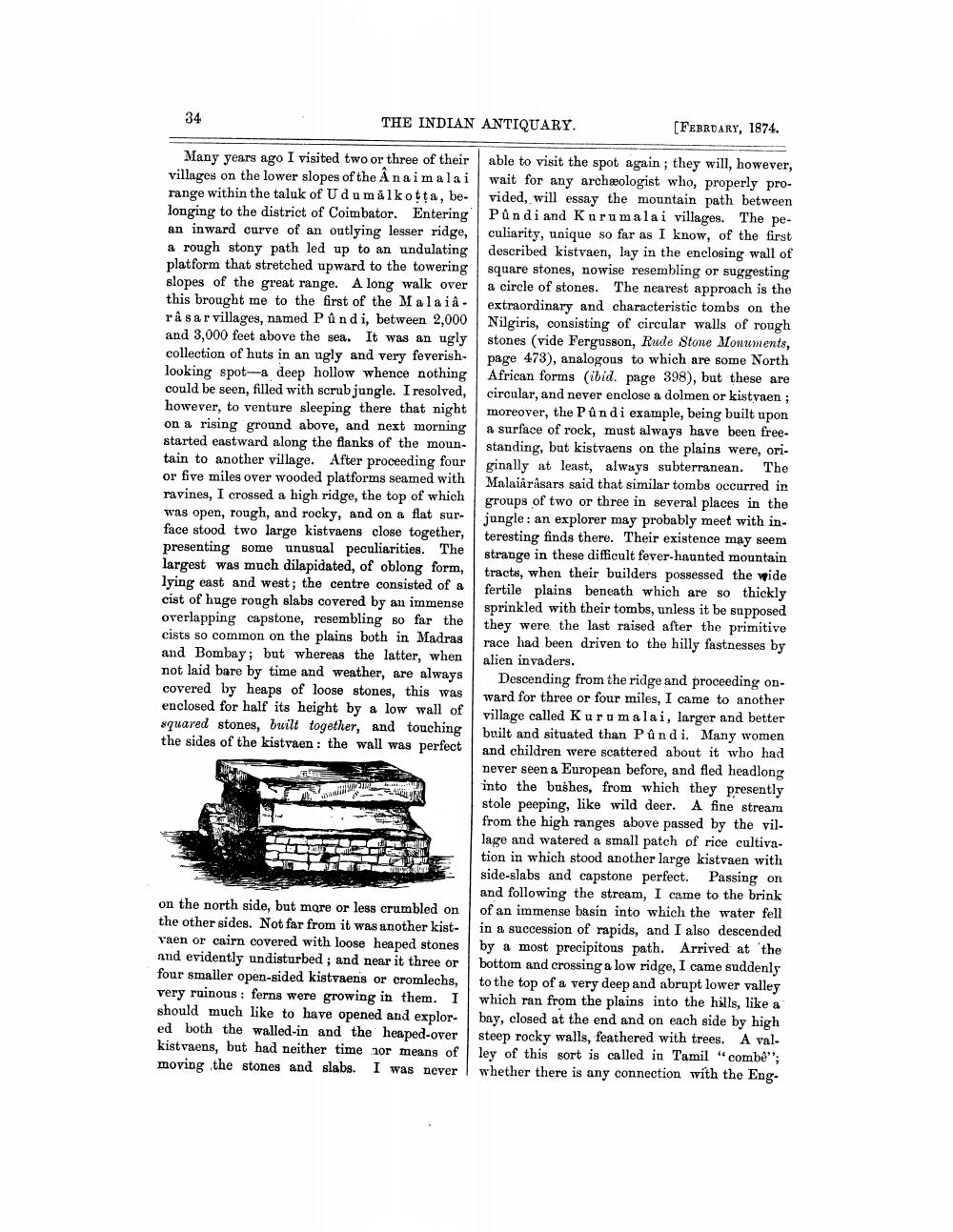________________
34
THE INDIAN ANTIQUARY.
Many years ago I visited two or three of their villages on the lower slopes of the Âna i malai range within the taluk of Udumalkoṭṭa, belonging to the district of Coimbator. Entering an inward curve of an outlying lesser ridge, a rough stony path led up to an undulating platform that stretched upward to the towering slopes of the great range. A long walk over this brought me to the first of the Malaiâ råsar villages, named P ûndi, between 2,000 and 3,000 feet above the sea. It was an ugly collection of huts in an ugly and very feverishlooking spot-a deep hollow whence nothing could be seen, filled with scrub jungle. I resolved, however, to venture sleeping there that night on a rising ground above, and next morning started eastward along the flanks of the mountain to another village. After proceeding four or five miles over wooded platforms seamed with ravines, I crossed a high ridge, the top of which was open, rough, and rocky, and on a flat surface stood two large kistvaens close together, presenting some unusual peculiarities. The largest was much dilapidated, of oblong form, lying east and west; the centre consisted of a cist of huge rough slabs covered by an immense overlapping capstone, resembling so far the cists so common on the plains both in Madras and Bombay; but whereas the latter, when not laid bare by time and weather, are always covered by heaps of loose stones, this was enclosed for half its height by a low wall of squared stones, built together, and touching the sides of the kistvaen: the wall was perfect
on the north side, but more or less crumbled on the other sides. Not far from it was another kistvaen or cairn covered with loose heaped stones and evidently undisturbed; and near it three or four smaller open-sided kistvaens or cromlechs, very ruinous: ferns were growing in them. I should much like to have opened and explored both the walled-in and the heaped-over kistvaens, but had neither time nor means of moving the stones and slabs. I was never
[FEBRUARY, 1874.
able to visit the spot again; they will, however, wait for any archeologist who, properly provided, will essay the mountain path between Pûndi and Kurumalai villages. The peculiarity, unique so far as I know, of the first described kistvaen, lay in the enclosing wall of square stones, nowise resembling or suggesting a circle of stones. The nearest approach is the extraordinary and characteristic tombs on the Nilgiris, consisting of circular walls of rough stones (vide Fergusson, Rude Stone Monuments, page 473), analogous to which are some North African forms (ibid. page 398), but these are circular, and never enclose a dolmen or kistvaen; moreover, the P ûndi example, being built upon a surface of rock, must always have been freestanding, but kistvaens on the plains were, originally at least, always subterranean. The Malaiârâsars said that similar tombs occurred in groups of two or three in several places in the jungle: an explorer may probably meet with interesting finds there. Their existence may seem strange in these difficult fever-haunted mountain tracts, when their builders possessed the wide fertile plains beneath which are so thickly sprinkled with their tombs, unless it be supposed they were the last raised after the primitive race had been driven to the hilly fastnesses by alien invaders.
Descending from the ridge and proceeding onward for three or four miles, I came to another built and situated than Pûndi. Many women village called Kurumalai, larger and better and children were scattered about it who had never seen a European before, and fled headlong into the bushes, from which they presently stole peeping, like wild deer. A fine stream from the high ranges above passed by the vil lage and watered a small patch of rice cultivation in which stood another large kistvaen with side-slabs and capstone perfect. Passing on and following the stream, I came to the brink of an immense basin into which the water fell in a succession of rapids, and I also descended by a most precipitous path. Arrived at the bottom and crossing a low ridge, I came suddenly to the top of a very deep and abrupt lower valley which ran from the plains into the hills, like a bay, closed at the end and on each side by high steep rocky walls, feathered with trees. A valley of this sort is called in Tamil "combê"; whether there is any connection with the Eng




